10/18/2014. Finally a clear, moon-free night and significant progress on the way to an effective deep-sky rig for the RV. My birthday SSD (Crucial MX100, 256GB) took some time off the PixInsight benchmark by cutting swap times in half, or a little more (total time: 6m 39s). I think I'll call it done with SSD upgrades until and unless terabyte versions get much cheaper than they already are. Consider that cutting swap times all the way to zero would only trim another minute and change from the benchmark. Installed as my new C: drive, its real virtues include faster bootups, snappy program launches, and delay-free window changes. Meanwhile, the computer is busy processing last night's take. I'm particularly pleased by PI's excellent alignment routines and its tools for preserving dynamic range in aggressively processed images. Here in the real world away from benchmarks, I need to speed things up considerably. More about that down below. Here are faint IC 59 and IC 63 shining in the light of Gamma Cassiopeia (they're the small "ghost" shapes at noon and 2 o'clock from the bright star):
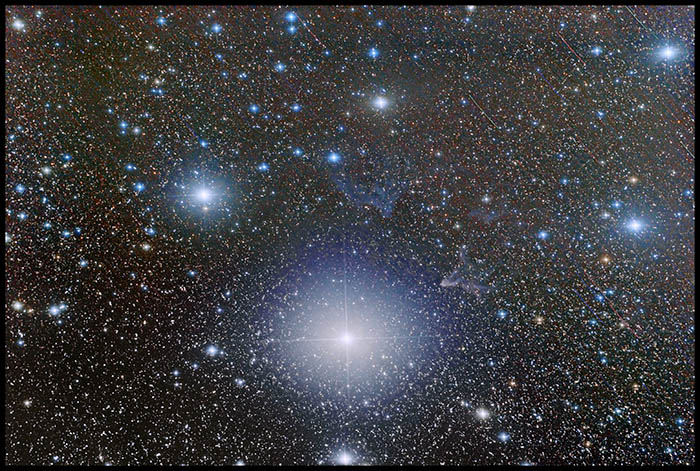
IC 59 & 63 beside Gamma Cas
95 x 30s Canon 6D, ISO 1600
10" F4 on G11 unguided
Click the image.
I used PixInsight for all the heavy lifting (alignment, calibration, stacking, stretching) and Photoshop for polish and cloning out hot pixel tracks. I need to play with the pixel exclusion options in PI's image integration tool. The default pixel rejection settings in PI's canned preprocessing script are pretty good. Unfortunately, I calibrated the image above and then stacked it in separate steps. While combining, I didn't specify any pixel rejection parms at all. Live and learn. [Sunday PM: I reprocessed the finised stack using some newly-learned color calibration techniques. The new version is displayed here. This time I've left a few hot tracks in the upper right.]
I also shot M31 and M45. Calibrating, registering, and stacking these huge piles of data takes PI hours (and not just 2 or 3).
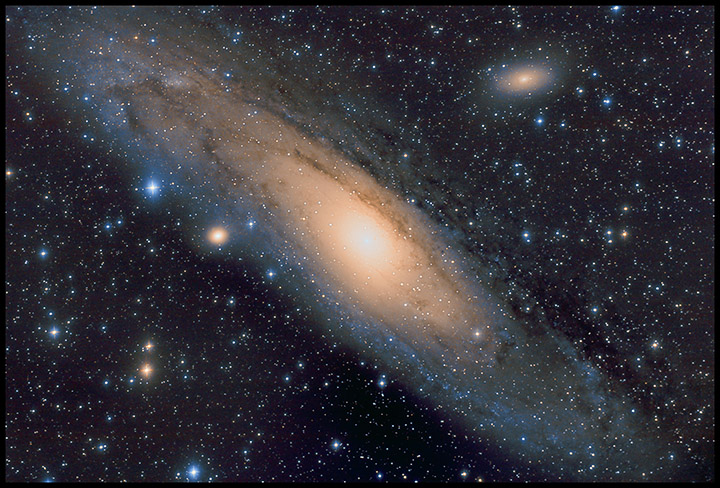
M31
120 x 30s Canon 6D, ISO 1600
10" F4 on G11 unguided

M45
75 x 30s Canon 6D, ISO 1600
10" F4 on G11 unguided
Yeah, some dew interferes with the faint nebulosity in the photo of the Pleiades, and the left side of the histogram has been brutalized a bit. Call this practice for darker, drier climes. Calibration, registration, and integration of M31's 120 subframes took ~8 hours. The fastest computers shown on PI's benchmark would presumably do it in one hour or a little less, but I do not think the most rational move involves buying something with multiple Xeon processors, 64GB of RAM, and a couple of optimized SSDs (it would make a good excuse to buy a tricked out Mac Pro, but not good enough). I could cut the processing time by a factor of ten if I could use 5 minute subs rather than 30s subs. Five minute subs will require guiding and darker skies, but even 2 minute subs under my skies would speed things up by a factor of four. Shall I spend like mad on high speed computing hardware or use tools already in hand? Guess. Next up: guiding the G-11 with the STV. Wish me luck.
10/19/2014. Retro night under the stars. I fired up the STV, stumbled through its menus, buttons, and knobs, and got the sensor focused behind the 165mm FL 50mm guider (note: the point of best focus is about 4mm out from full in). I enjoyed very little success after that. I got "no movement" failures on every attempt to calibrate the guider.
The problem could lie with 1) the STV, 2) the cable, or 3) the G-11 electronics. I attached a hand controller and determined that the G-11 electronics are working, and I have no reason to suspect the STV. So I'll take door number 2: it's a cable thing. Some of the literature says that pins 1-6 run straight through to define the ST4 standard, but I found at least as many sources saying that 1-6 on one end must connect to 6-1 on the other (that is, no pairs are crossed, but the connectors are inverted on opposte ends of the cable; it just depends on how you hold the plugs in the crimping tool, locking tab up or locking tab down). I excavated several 6-wire RJ-11 cables to inspect and to try on the next clear night. As it happens, I have cables of each sort; expect success.
How do I make an STV work with a non-Gemini G11 is one of those questions that is almost answered in many, many place on the internet. I'll have the definitive answer in a day or two.
10/21/2014. Bingo! It was the cable. Hold the cable with both connectors side by side, tabs down so you can see the wires inside. The wire order in one connector should be a mirror image of the wires in the other: 1-6 on one side, 6-1 on the other. You do not need a relay box.
I've adopted a folding laptop stand to hold the STV at a convenient angle, down low to the ground. It holds the big Dell computer case with space and capacity to spare so the guider need not be unpacked. The side of the case opens up which allows it to serve as a robust dew cover. Pictures soon down below.
I'm not pressing my luck tonight. After focusing the STV on Vega (press 'Focus' twice, fiddle with the sensor until the blur is smallest and brightest), I used auto-everything: press 'Calibrate' twice (once to say you want to calibrate, again to accept auto mode); and then after a successful calibration, press 'Track' twice (once to say you want to track, again to accept auto mode). Let the software set times, gains, exposures, rates, and the default 100% aggressiveness. Let it pick a temperature. Tonight I'm just letting it do its thing. The STV is said to be really good at this -- let's find out if it needs to be second-guessed before going all monkeys-on-keyboards with it.
Note that the guide rate on the G-11 needs to be faster than 0.3x (or the calibration time needs to be increased). When I set the G-11 guide corrections to 0.3x, the STV saw no or insufficient motion while exercising the first relay. I changed to 2x and calibration worked without drama. I've left the outfit making 2 minute exposures of M31 as I type this which is tempting fate. (Right: I went out to check on it. I'd left the shutter set for '30s' rather than 'bulb.' Fixed that after 20 minutes.) I had in mind going a couple of hours. We'll see how long the Kendrick battery pack lasts and if there is room on this side of the meridian for that long a run. Tracking looked good for the exposures in the can when I reset the shutter; the Kendrick battery pack was down to 12.1v, however. It has not been recharged since driving the G11 for 5-6 hours and powering the STV for almost an hour while testing this and that. Still... I'm already thinking about how to get more juice for longer sessions with the guider. Keep it simple. Do not rely on dialing down the cooling; the chip is kept cold for a reason (and, btw, check for frost just in case). It's always something. It's always three or four things, actually. After unplugging the STV for the night, the voltmeter went from 11.9 to 12.2 volts, FWIW.
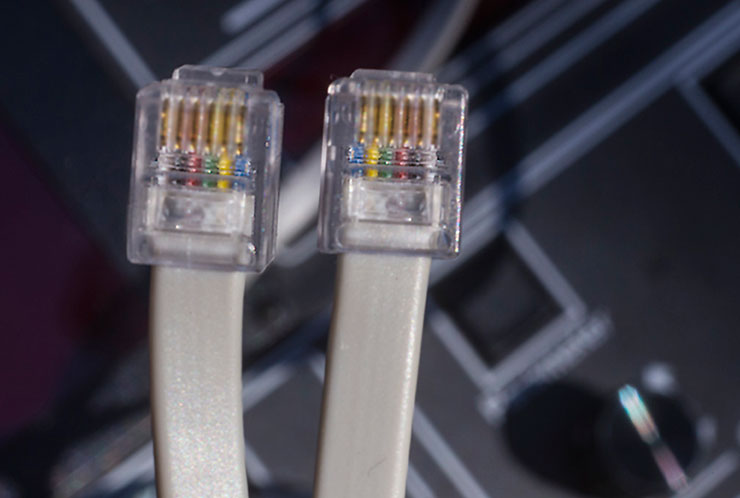 |
Wiring of guide cable from STV to G-11 control port (use your browser's "view image" features for a closer look). |
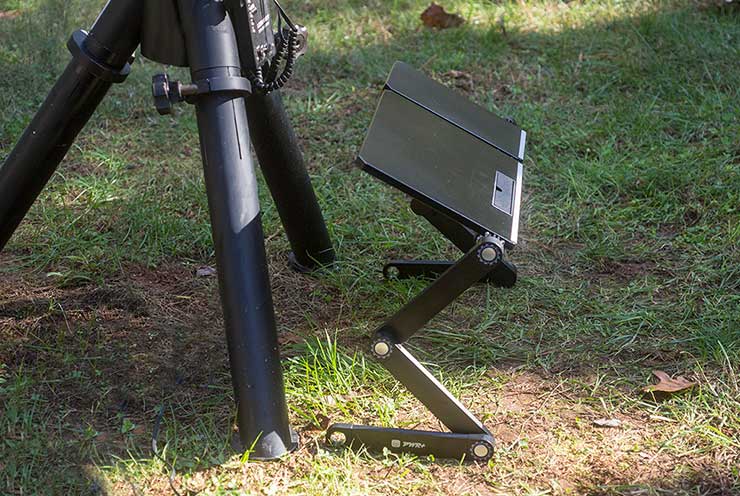 |
Folding laptop stand in place, ready for STV. |
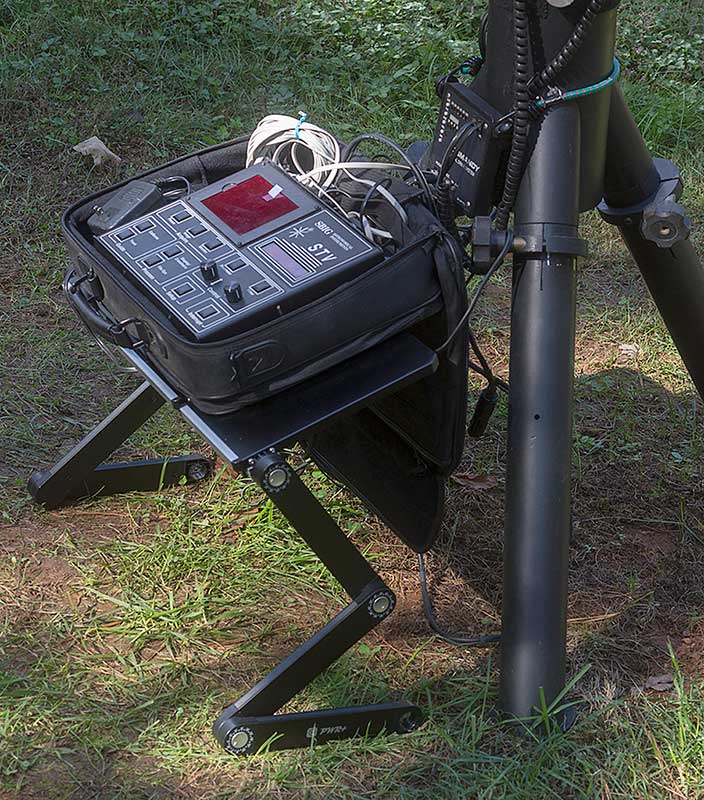 |
STV ready for action, less battery which is being recharged. (Yes, I do suddenly realize that the case will work better if I turn the STV around in it. Done.) |
Comedy tonight. (1) About the remote release / intervalometer on the Canon. If you want 2 minute exposures with 5 second gaps between them, set the interval to 5 seconds, not to 2m05s. (2) Do not balance the G-11 so well. RA guiding went to hell near the meridian; I suspect the mount was bouncing between adjacent teeth. Try tracking at 0.5x so that the RA drive never reverses [nope, 4th relay saw no movement]. 1x would be better, but that's not available(!). Program the PEC at the start of every run; I don't think it will hurt; repeat when changing sides of the meridian? (3) Find some simple timers I can use to leave things running and go to bed without danger of damaging the batteries. (4) Use a multiple outlet adapter so a single timer wired between plug and outlets will suffice to cutoff everything, also so that I can have one unswitched port and a means to experiment with providing an auxillary battery via existing circuitry.
Guiding was excellent except for the meridian / bouncing issue which cost a few subs. Owing to that and the mis-set timer, I only got 26 minutes of exposure, but the two minute subs and their stack are beauteous. Note that I'm saving some bandwidth by declining to show off a well-guided version until I get one with more subs; I have ideas. Of course I do.
Nice. For the first time in ages, I am not "solving problems" on the portable deep-sky outfit; I am "making improvements."